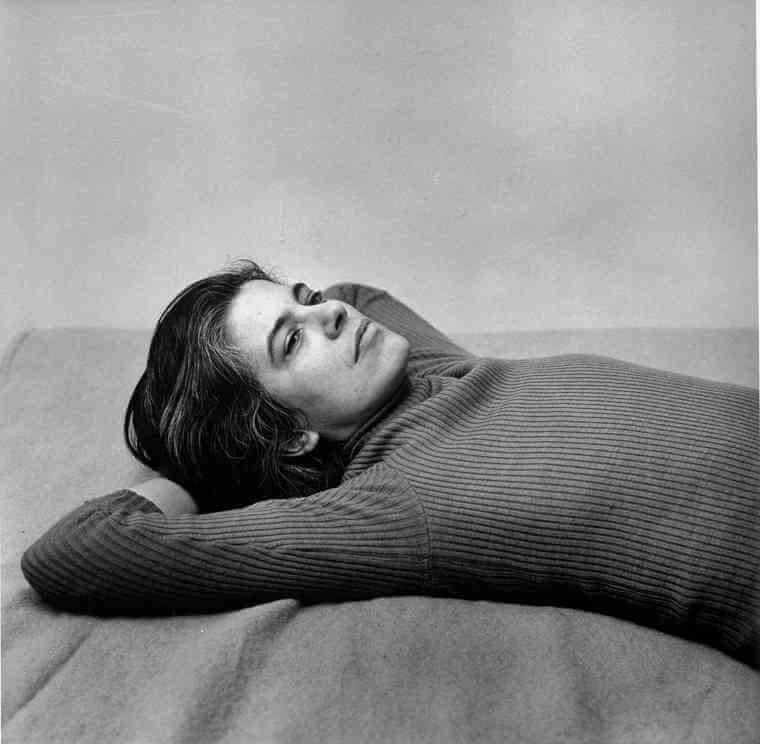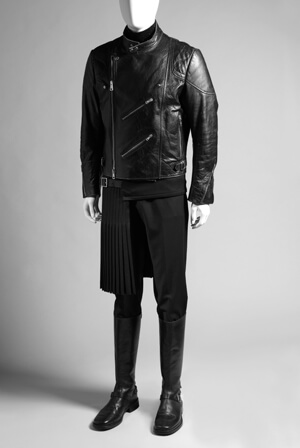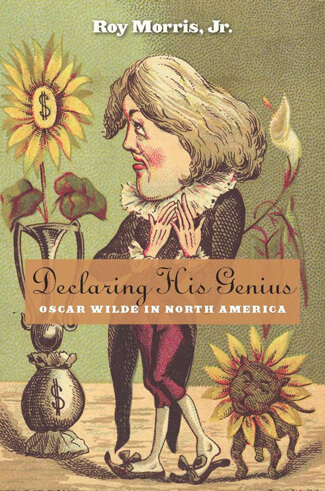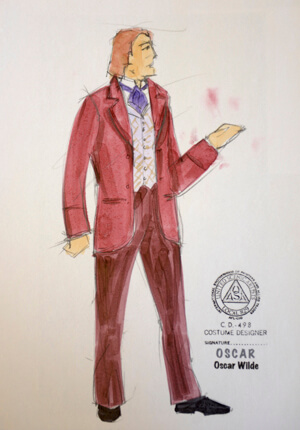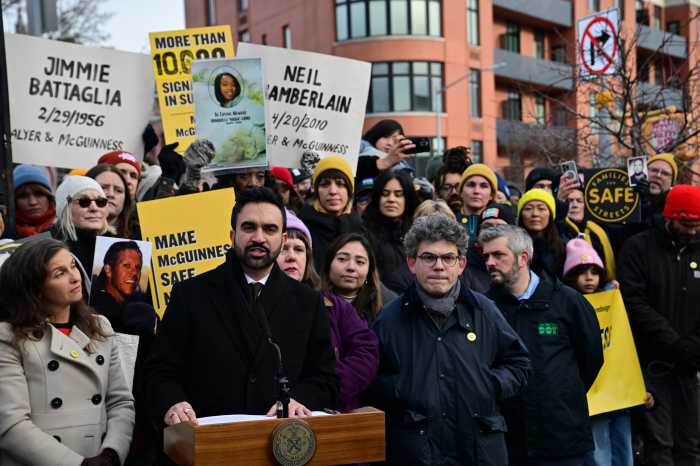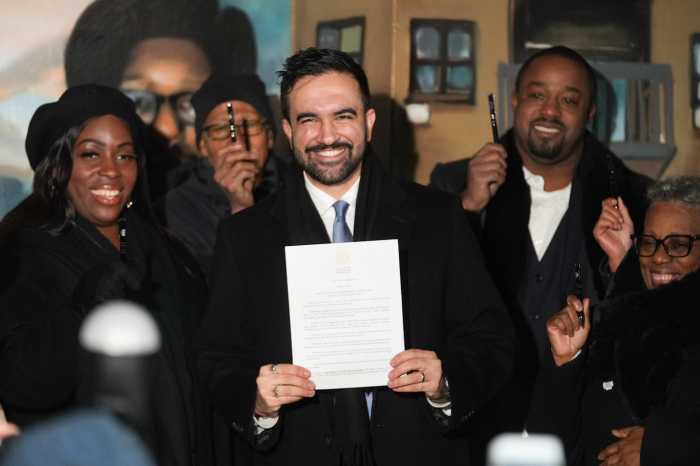With Stonewall 50 here, it is only fitting that our most prominent museums are featuring exhibits with a gay focus. Although it is not an exclusively queer-themed show, as was Fashion Institute of Technology’s “A Queer History of Fashion” in 2013, this year’s Metropolitan Museum of Art Costume Institute is focusing on “Camp: Notes on Fashion.”
Long considered the provenance of gay men, camp is defined in Merriam Webster as “something so outrageously artificial, affected, inappropriate, or out-of-date as to be considered amusing,” or “style or mode of personal or creative expression that is absurdly exaggerated and often fuses high and popular culture” or “exaggerated effeminate mannerisms (as of speech or gesture).”
The Met exhibit, curated by Andrew Bolton, traces the origin of the word back to 17th century France, specifically to a Moliere play in which the French phrase “se camper” (“to flaunt” or “posture”) first appears.
And, of course, there was that little shindig accompanying the show’s opening, modestly referred to as “The Party of the Year,” presided over Vogue’s redoubtable editrix Anna Wintour. This year, watching the red carpet arrivals had an added frisson as we could pass merciless hoi polloi judgment as to who actually got the risky concept of camp and who failed miserably. Fashionistas, admittedly, are usually not known for a density of gray matter — let alone a healthy sense of humor, especially about themselves (essential to camp) — and it would seem they largely took the theme to mean “outrageous,” grimly plying on more layers of tulle, mile-long trains, vertiginous headpieces, and other big dressy statements than the fragile size zero frames of their model dates du jour could accommodate, making many of them look slightly in pain under the weight of these confections.
Once inside, the show presented itself in two parts: the first dealing with the historic origin of camp and its earliest practitioners, followed by examples of its influence on fashion. Although, like everybody else, I had come to see the dresses, I was far more impressed — and educated — by Part I, which gratifyingly and justly threw a spotlight on the Godfather of Camp, Oscar Wilde, with his melancholy yet saturnine mien, captured in photos. They revealed a certain sartorial elan, with his nattily bespoke smoking jackets, displayed alongside modern couture knock-offs of his look.
Also on display was an item that made my heart stop for a second, the original manuscript of “De Profundis,” the heartbreaking letter to his wayward Bosie, summng up his life, which he wrote while in prison for immoraility.
Wilde shares his narrow corridor of the show — which was purposely planned this way, according to Bolton, to give you a sense of the cramped and constricted lives of so many of the people featured here — with some delightful, outrageous company. There’s Philippe, the Duke of Orléans, younger brother of Louis XIV, commonly referred to as “Monsieur,” who lived openly as a homosexual, much given to wearing feminine garments, taking numerous lovers who were both too handsome and too ambitious. Once describd a “the silliest woman who ever lived,” he supposedly lost his gay cherry to the nephew of Cardinal Mazarin, the Duke of Nevers, who seduced Monsieur into the corruption of the “Italian vice,” as homosexuality was then known.
Right across the way from him are Frederick “Fanny” Park and Ernest “Stella” Boulton, who were 19th century lovers and female impersonators, once accused of conspiring to seduce men by wearing women’s clothing (they beat the rap).

When you leave the claustrophobic confines of the distant past, there is a bridge area prominently featuring Susan Sontag, whose 1964 essay “Notes on Camp” was the impetus for this show and explained it all (well, sorta) for the general public. Camp could appear in many forms, she averred and, for me, off the top of my head I will cite these examples: weddings; Carmen Miranda; Tallulah Bankhead; Pee-wee Herman; Bette Midler pre-1990; the opera “Adriana Lecouvreur,” in which the evil diva avenges herself on the good one by sending her a poisoned nosegay; the culinary concept of amuse-bouche; the theatrical oeuvres of the Charleses — Ludlum and Busch (camp in its highest form, mind you) — James McCourt’s novel “Mawrdew Czgowchwz”; the films “Mahogany,” “The Oscar,” Butterfield 8,” and of course, “Mommie Dearest” and “Showgirls”; Neuschwanstein Castle, the fairy tale abode of the mad Ludwig of Bavaria, and the Belvedere, the gay guesthouse it inspired in Cherry Grove; Cherry Grove; and Roman Catholicism (indeed, the Met’s last show, “Heavenly Bodies,” about all the drag associated with that Church was the ultimate, unbeatable camp-fest).
Adjacent to the leonine portrait of Sontag hanging over her original manuscript for that essay is the huge, magnificent official royal portrait of Marie Antoinette, on loan from Versailles. This same image fascinated my seven-year-old self when I first saw it in an Encyclopedia Britannica. “Who is that?” I demanded of my Auntie Mary, babysitting me at the time. “Oh, she was the queen of France who had her head cut off.”
What? A queen, with that dress and that hair? And her head cut off? Perhaps my first real exposure to camp.
And now we come to the Big Moment, the Big Room where all the most important sartorial camp statements are on show. Like too many of the trying-too-hard-to-be-fabulous gowns here, one can feel the museum straining for the Ka-Pow effect, necessary to any endeavor that has its eye on the prize of being a blockbuster show.
The museum decided to show the drag on two separate levels. This two-story effect — first seen here in the disappointing Comme de Garcons show of 2017 — while visually striking, makes it impossible to really see the clothing up top, in a repeat decision of utter aesthetic pointlessness. Bob Mackie stage outfits worn by Liberace and Cher are presented rotely, as is one of Dietrich’s tuxedos. The designers are the big stars here, doncha know?
I was, however, happy to see the estimable likes of Galliano, Vivienne Westwood, and Gaultier represented, especially Gaultier. His entire career has had camp underpinnngs, from the bracelets he sold in his earliest collection, fashioned from used tin cans, to his consistent use of louche Cocteau-esque sailors as inspiration, to his memorable Frida Kahlo catwalk tribute, to the way he has androgynously and consistently bent the rules regarding menswear, through the use of skirts and such.
Franco Moschino, who rather came up at the same time as Gaultier, started a house that is going strong. Launched in 1983, it featured his classic tailoring and easy sexiness, all of it informed with a breezy, sometimes surreal irreverence, whether he was trimming a bodice with fried eggs or stamping the words “Expensive Jacket” on the back of such a garment. Two garments, one bearing a trompe-l’oeil ballerina applique and the other showing off the motto “Too Much Irony” attest to his unique and ever-prevalent sense of humor, which was sadly silenced by his death from AIDS in 1994 at age 44.
American Jeremy Scott was hired as creative director of the company n 2014. When he determinedly burst onto the scene in the ‘90s, I would have thought him to be the last one destined to sustain a long and successful career, as his early lines were weak to say the least, with gimmicky themes and shoddily made. He hung in there, though, and moved to Paris, at which point I thought, “That would be that.”

Then I hear, despite a disastrous attempt to revive the glitzed-out 1980s with a collection that was solid gold, Karl Lagerfeld went on record as saying he was the only designer fit to suceed him at Chanel. A partnership designing sneakers with Adidas really took off, bringing him another level of clients — from the music, entertainment and sports worlds. Design-wise, Scott shares with the late Moschino a love of pop culture and labels, with one big difference: Moschino had exquisite taste. Meanwhile, Scott dressed Katy Perry as a cornball crystal chandelier for the red carpet and then as a Big Mac for the afterparty. Scott has also gotten the official approval of La Wintour herself and was all over the opening night like an ostrich boa, arriving in a special party bus with his celeb coterie, Katy Perry, Gwen Stefani, Kacey Musgraves (who?), all draped by him.
Three more quibbles. That infamous dead swan ensemble Björk wore to an Oscar ceremony is on display, with no mention of the fact that it was a knock-off of a 1935 Marlene Dietrich costume designed by Travis Banton for her to wear to Dorothy DiFrasso’s “Come as someone you’d rather be” party. Dietrich had picked the Greek myth of Leda and the swan, and even had its blue eyes resewed to be green when she first saw the finished product (“I could never wear a swan whose eyes matched my own,” she purred. Now that’s camp.)
I also object to the use of Judy Garland singing “Over the Rainbow,” both as sparkling ingenue in 1939 and then as bitter, aged, broken Judy. There is absolutely nothing camp about this beautiful, heartfelt song, which possesses the utter simplicity of any truly great thing, as well as a timeless message of hope that has inspired generations. Okay, curators? If you are positing the fact that Garland was camp, you are absolutely entitled to — her sense of humor definitely was camp. And if you want to see her do something really camp, try watching her “Madame Crematon” number in “Ziegfeld Follies of 1946.”
There’s a certain lack of inclusion in the designer selection. The late Patrick Kelly, who lit up all Paris with his audacious use of certain black culture bugaboos like watermelon earrings or golliwog dolls as pins and by taking Parisian trademarks and throwing them into his own sartorial mix (Eiffel Tower hats, his own face on T-shirt but presented like the Mona Lisa), should definitely have been selected, along with others.
One real pleasure of attending the Met press preview every year is seeing Stephen Jones, perhaps the greatest milliner ever — so wam, so bright, so talented. Each year he creates headpieces or “wigs” for the mannequins in the show (150 this time). Nattily turned out in Brit tweed, he enthused, “I loved working on this one. The clothes are so remarkable. Andrew and I agreed that we should go low key on the heads this year as the costumes are so extravagant. Less was more. I did get to do some hats for the collection of feathered dresses, though. For those I drew inspiration from Madame Upanova, the lead ostrich dancer in ‘Dance of the Hours,’ in Disney’s “Fantasia.”
Jones also made my favorite piece in the show, and the one that perfectly and succinctly sums up the notion of camp. It’s a little cocktail chapeau — in pink, the same shade that gaily dominates the walls of the exhibit — that he did for a John Galliano show in 2005, really consisting of nothing more than a luscious pair of lips with ribbons attached to fasten it to the head. But those lips are inflatable plastic, and this fun, unexpected surprise, combined with its homage to Dali’s painting of Mae West’s lips (also made into a sofa), as well as evoking the tiny, adorable “doll hats” of the late 1930s and 1940s women loved to wear when having drinkies, make this one campy number, all the way.
That same spirit of fun thoroughly suffuses the exhibit and whatever quibbles one might have with the presentation or selection, it is a total lark, exactly what anything designated as “camp” should be.
By the way, if you stop in at the Met gift store, for $125 you can own a silk scarf, printed over with images of the multi-hued bandanas that gay men back in the day wore in their left or right hand pockets to silently communicate their sexual proclivities and positions. Is that camp or cultural appropriation?

CAMP: NOTES ON FASHION | The Metropolitan Museum of Art, 1000 Fifth at E. 82nd St. | Through Sep. 8: Sun. –Thu., 10 a.m.-5:30 p.m.; Fri. & Sat., 10 a.m.-9 p.m. | $25; $17 for seniors; $12 for students | metmuseum.org

